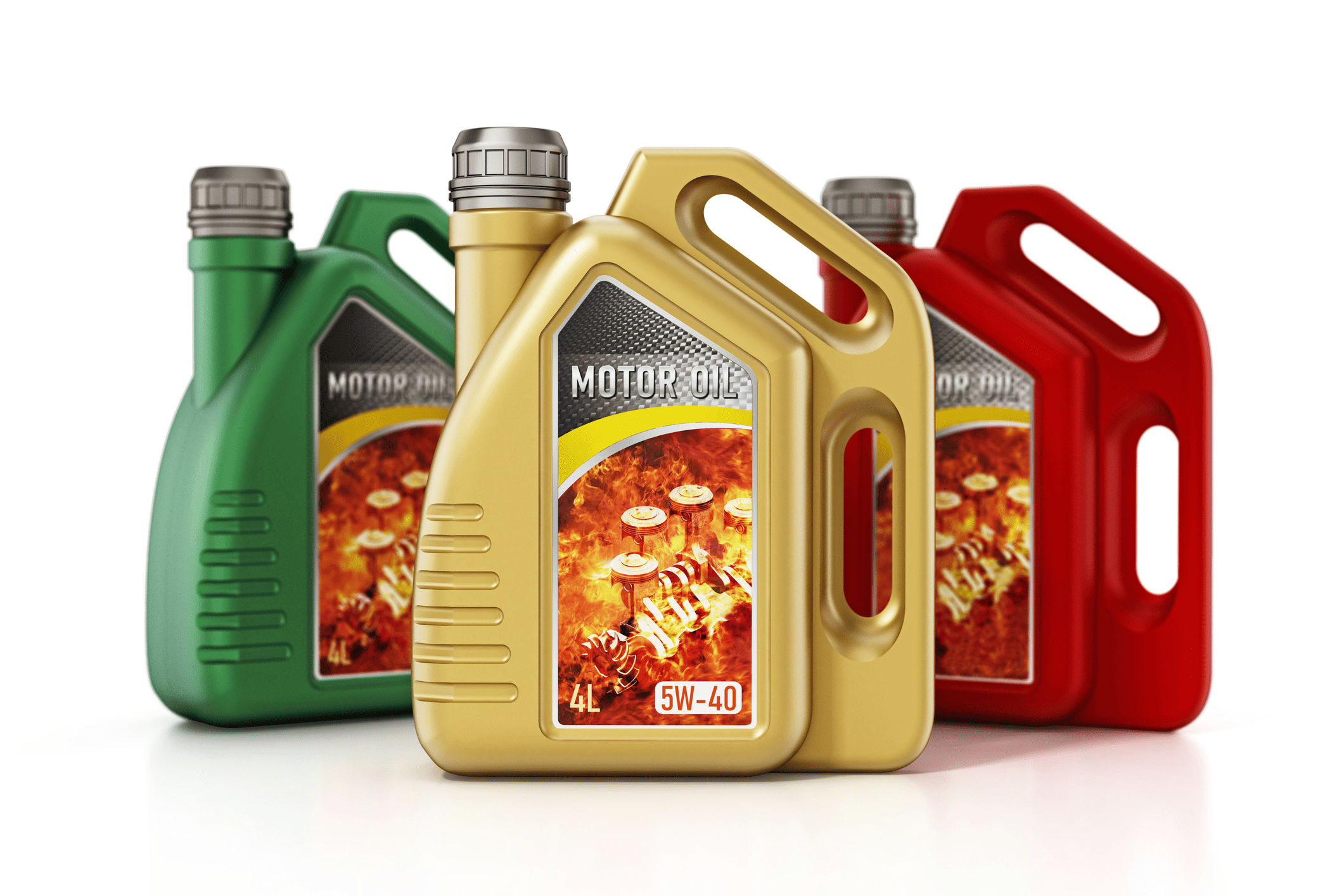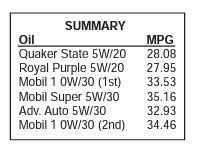Better Mileage with Synthetic?
We experiment to see if brand makes a difference

One afternoon a customer emailed us and said he gets better mileage when he’s using synthetic oil. To be honest, we were skeptical. If you’ve been with us long enough, you know we generally think that oil type doesn’t matter. Use Oil A for 5,000 miles and do a sample to check your metals, then use Oil B for the same miles and resample. Most people will find that their engine wears just the same regardless of oil brand. But here is an angle we hadn’t tested — is fuel economy affected by your choice of oil? We decided to try and find out.
Designing the experiment
When we first started talking about a fuel economy experiment, we came up with a lot of questions. How will we know how much fuel we’re actually using? How will we take into account tire pressure and other things that can affect fuel economy? Do we need to take into consideration the natural expansion of gas at different temperatures?
We eventually decided on the following plan. It’s probably not scientific enough for a MythBusters special, but it’s about as good as we could get without installing special pumps and meters, and it should be repeatable if you want to give it a shot in your own vehicle.
Counting miles was the easy part — we just recorded miles at every gas fill-up. Figuring the “per-gallon” was a little trickier, since we don’t really have an accurate way to measure fuel consumption.
In an episode of MythBusters where they were doing something that involved calculating miles/gallon, they took an old clunker, removed the hood, and rigged up a container that measured fuel consumption to the milliliter. That’s a little more involved than we wanted to get, especially since our guinea pigs are analysts Amanda and Alex’s daily driver vehicles.
We ended up recording the number of gallons needed to fill up at the pump. We decided to resist the urge to “top-off” the tank when filling and just stop pumping whenever the pump stopped. Is this a perfect measure of fuel usage? Certainly not. Every pump could be a little different in its stopping point depending on the day, the pump, the volume/speed of fuel dispensed, ambient temperature, and so on…but these things are impossible to control in the real world.
We decided to do ten gas fill-ups on each type of oil. With ten fill-ups, we’d have enough data to take into account some of those variables mentioned above that we can’t control. We also made a note to monitor tire pressure, though that varied so little that we thought it negligible.
Royal Purple vs. Quaker State
Amanda started with Quaker State Advanced Durability 5W/20. The price at O’Reilly Auto Parts was $5.29/quart or $23.99 for a handy 5-quart bottle, which is just perfect for her Kia, which takes 4.8 quarts of oil. She ran that oil in her car from May to June 2013. In ten gasoline fill-ups, she ran 3,703.7 miles and used 131.858 gallons, for a fuel economy of 28.09 miles/gallon.
She decided that 3,703.7 miles was too early to change her oil, so she kept running that oil for a total of 6,333 miles and changed the oil on July 27, 2013. The result was some good wear numbers (see figure 1, F66495).
On to the synthetic! Royal Purple 5W/20 costs $9.79/quart at O’Reilly Auto Parts and does not come in a handy 5-quart jug, so we ended up paying $48.95 for oil on this oil change. Amanda ran this oil from the end of July until October, going 3,829.2 miles and using 137.002 gallons of fuel, for a final fuel economy of 27.95 miles/gallon, a decrease of 0.5% compared to the Quaker State conventional.
| Oil | Price/5 gal. | Miles | Gals. | MPG |
| Quaker State 5W/20 | $23.99 | 3703.70 | 131.89 | 28.08 |
| Royal Purple 5W/20 | $48.95 | 3829.20 | 137.00 | 27.95 |
Amanda ran the Royal Purple a total of 14,277 miles before changing it (we’re all for getting our money’s worth out of an oil change!), and ended up with a little more wear than usual (figure 2, G22246).
The two oils are very close in terms of fuel economy, with the conventional Quaker State slightly edging out the more expensive Royal Purple. But in the spring of that year she was doing a little more highway driving than in the fall, with a few trips between Illinois and Green Bay, Wisconsin, and so on. Even so, the added cost for the oil itself almost certainly defeats any slight improvement in MPG she might have gotten. So let’s look at Alex’s numbers.
Mobil 1 vs. Mobil Super & Advance Auto Parts 5W/30
Alex spent $34.85 for five quarts of Mobil 1 Advanced Fuel Economy 0W/30 at Wal-Mart and ran the oil from January 2013 to May 2013. He traveled 3,061.1 miles, used 91.3 gallons of gas and ended up with a fuel economy of 33.53 miles/gallon.
Then he bought five quarts of Mobil Super 5W/30 conventional oil for $18.10 and ran 3,234.9 miles on 92.0 gallons of fuel from June to October 2013, for an average fuel economy of 35.16 miles/gallon¾a difference of 4.9% in favor of the conventional oil.
| Oil | Price/5 gal. | Miles | Gals. | MPG |
| Mobil 1 AFE 0W/30 | $34.85 | 3061.10 | 91.30 | 33.53 |
| Mobil Super 5W/30 | $18.10 | 3234.90 | 92.00 | 35.16 |
Alex noted that his engine tends to get better fuel economy in general in the warmer months than the colder months, so he repeated the experiment again the following year, using Advance Auto Parts 5W/30 conventional oil from February to March 2014, getting 32.93 MPG.
He then ran Mobil 1 Advanced Fuel Economy 0W/30 from May to August, getting an average fuel economy of 34.46 miles/gallon. In this case, Mobil 1 did beat the conventional oil, but his mileage still wasn’t as good as on the original run of Mobil Super 5W/30 conventional, and the added cost of the oil negates any extra miles-per-gallon.
Alex mentioned that on synthetic oil his engine seemed to burn less oil, but since that wasn’t the point of the experiment, we didn’t get too deep into trying to quantify that.
Synthetic or conventional?
So…which oil to choose? We get asked this question hundreds of times a year on the phone, in e-mails, and written on oil slips. And honestly, from a wear standpoint, we don’t find a lot of difference between conventional and synthetic oils. Some engines may run better on one than the other, or maybe you find that your engine uses less oil on one or the other, but these things are hard to quantify from our end. 
There are so many factors that affect how your engine wears, what kind of mileage you get, and how long your engine will last that we could never issue a blanket one-size-fits-all statement saying “You should use X.”
We did not find that synthetic oil gave us better fuel economy, but that doesn’t mean that you won’t. Feel free to try this experiment at home and let us know what you find. Or, if you’re not experimentally-inclined and you’re wavering about what oil to use, feel free to use whatever fits your wallet. Any API-certified oil is going to be quality oil, and your engine should be happy with whatever you choose.
Related articles
A New Wave
Saying goodbye to my 1984 Chevy
TBNs & TANs: Part 2
Determining how heat affects the TBN and TAN of the oil
Finishing the RV-12
The last article in our series on finishing the RV-12
In the Thick of it!
Five cities, five days, 5000+ cars: the 2024 Hot Rod Power Tour!









